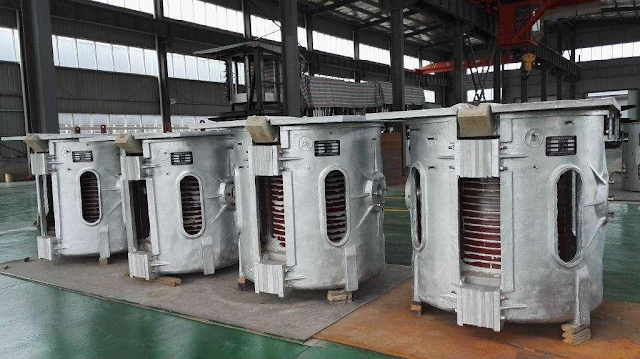How Does an Electric Induction Furnace Work?
The electric induction furnace is a power supply device that converts the power frequency of 50HZ alternating current into an intermediate frequency (above 300HZ to 1000HZ). It converts three-phase power frequency alternating current into direct current after rectification and then converts direct current into adjustable intermediate frequency current, which is supplied by capacitors. And the medium-frequency alternating current flowing in the induction coil generates high-density magnetic force lines in the induction coil, and cuts the metal material contained in the induction coil, generating a large eddy current in the metal material.
The working frequency of an electric induction furnace (hereinafter referred to as an intermediate frequency furnace) is between 50 and 10 Hz, and it is widely used in the smelting of non-ferrous metals and ferrous metals. Compared with other casting equipment, the medium-frequency induction furnace has the advantages of high thermal efficiency, short melting time, less burning loss of alloy elements, a wide range of melting materials, less environmental pollution, and precise control of the temperature and composition of molten metal.
So, how does an electric induction furnace work?
Working Principle of Electric Induction Furnace
The intermediate frequency furnace is mainly composed of a power supply, an induction coil, and a crucible made of refractory materials in the induction coil. The crucible is filled with a metal charge, which is equivalent to the secondary winding of the transformer. When the induction coil is connected to the AC power supply, an alternating magnetic field is generated in the induction coil, and its magnetic field lines cut the metal charge in the crucible, and an induced electromotive force is generated in the charge. Since the charge itself forms a closed circuit, the secondary winding is characterized by only one turn and is closed. Therefore, an induced current is generated in the charge at the same time, and when the induced current passes through the charge, the charge is heated to promote its melting.
When the magnetic flux surrounded by the conductor loop changes, an induced potential will be generated in the loop. Similarly, a conductor in an alternating magnetic field will also generate an induced potential under the action of electromagnetic induction, forming an induced current (eddy current) in the conductor ), the induced current overcomes the resistance of the conductor itself to generate Joule heat, and uses this heat to heat the conductor itself to heat up and melt it to achieve various thermal processing purposes. This is the principle of intermediate frequency induction heating.
The electric induction furnace uses the intermediate-frequency power supply to establish the intermediate-frequency magnetic field so that the induced eddy current is generated inside the ferromagnetic material and heats up, so as to achieve the purpose of heating the material. The intermediate-frequency electric furnace adopts a 200-2500Hz intermediate-frequency power supply for induction heating, smelting, and heat preservation. The intermediate frequency electric furnace is mainly used for melting carbon steel, alloy steel, and special steel, and can also be used for melting and heating non-ferrous metals such as copper and aluminum. The equipment is small in size and heavy in weight. Lightweight, high efficiency, low power consumption, fast melting and heating up, easy control of furnace temperature, high production efficiency.
Multi-occasion Application of Electric Induction Furnace
(1) Heated forging of standard parts
(2) Melting of various metal materials
(3) Motor rotor heating fit
(4) Heating pipe expansion at the end of the steel pipe
(5) Mold diathermy
(6) Intermediate frequency quenching for shafts
(7) Weld seam preheating or tempering after welding, etc.

评论
发表评论